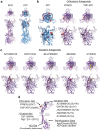Ionotropic purinergic receptor 7 (P2X7) channel structure and pharmacology provides insight regarding non-nucleotide agonism
- PMID: 38762911
- PMCID: PMC11110710
- DOI: 10.1080/19336950.2024.2355150
Ionotropic purinergic receptor 7 (P2X7) channel structure and pharmacology provides insight regarding non-nucleotide agonism
Abstract
P2X7 is a member of the Ionotropic Purinergic Receptor (P2X) family. The P2X family of receptors is composed of seven (P2X1-7), ligand-gated, nonselective cation channels. Changes in P2X expression have been reported in multiple disease models. P2Xs have large complex extracellular domains that function as receptors for a variety of ligands, including endogenous and synthetic agonists and antagonists. ATP is the canonical agonist. ATP affinity ranges from nanomolar to micromolar for most P2XRs, but P2X7 has uniquely poor ATP affinity. In many physiological settings, it may be difficult to achieve the millimolar extracellular ATP concentrations needed for P2X7 channel activation; however, channel function is implicated in pain sensation, immune cell function, cardiovascular disease, cancer, and osteoporosis. Multiple high-resolution P2X7 structures have been solved in apo-, ATP-, and antagonist-bound states. P2X7 structural data reveal distinct allosteric and orthosteric antagonist-binding sites. Both allosteric and orthosteric P2X7 antagonists are well documented to inhibit ATP-evoked channel current. However, a growing body of evidence supports P2X7 activation by non-nucleotide agonists, including extracellular histone proteins and human cathelicidin-derived peptides (LL-37). Interestingly, P2X7 non-nucleotide agonism is not inhibited by allosteric antagonists, but is inhibited by orthosteric antagonists. Herein, we review P2X7 function with a focus on the efficacy of available pharmacology on P2X7 channel current activation by non-nucleotide agonists in effort to understand agonist/antagonist efficacy, and consider the impact of these data on the current understanding of P2X7 in physiology and disease given these limitations of P2X7-selective antagonists and incomplete knockout mouse models.
Keywords: P2X7; P2XR; extracellular histones; non-nucleotide agonism.
Conflict of interest statement
No potential conflict of interest was reported by the author(s).
Figures

Similar articles
-
Activation and regulation of purinergic P2X receptor channels.Pharmacol Rev. 2011 Sep;63(3):641-83. doi: 10.1124/pr.110.003129. Epub 2011 Jul 7. Pharmacol Rev. 2011. PMID: 21737531 Free PMC article. Review.
-
High-affinity agonism at the P2X7 receptor is mediated by three residues outside the orthosteric pocket.Nat Commun. 2024 Aug 6;15(1):6662. doi: 10.1038/s41467-024-50771-6. Nat Commun. 2024. PMID: 39107314 Free PMC article.
-
Purinergic P2X receptors: structural models and analysis of ligand-target interaction.Eur J Med Chem. 2015 Jan 7;89:561-80. doi: 10.1016/j.ejmech.2014.10.071. Epub 2014 Oct 25. Eur J Med Chem. 2015. PMID: 25462266
-
Lithocholic acid inhibits P2X2 and potentiates P2X4 receptor channel gating.J Steroid Biochem Mol Biol. 2020 Sep;202:105725. doi: 10.1016/j.jsbmb.2020.105725. Epub 2020 Jul 8. J Steroid Biochem Mol Biol. 2020. PMID: 32652201
-
[Purinergic P2X family and specific features of the P2X7 subtype].Cesk Fysiol. 2013;62(2):40-6. Cesk Fysiol. 2013. PMID: 24392594 Review. Czech.
References
-
- Ralevic V, Burnstock G. Receptors for purines and pyrimidines. Pharmacol Rev. 1998. Sep;50(3):413–492. - PubMed
Publication types
MeSH terms
Substances
Grants and funding
LinkOut - more resources
Full Text Sources
